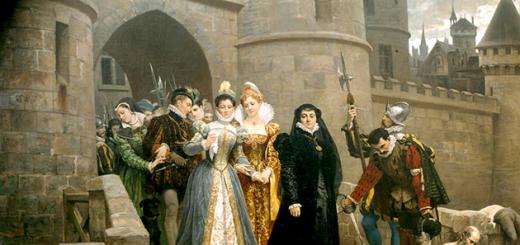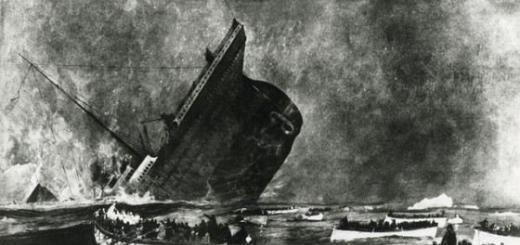Send your good work in the knowledge base is simple. Use the form below
Students, graduate students, young scientists who use the knowledge base in their studies and work will be very grateful to you.
Posted on http://www.allbest.ru/
The reign of Ivan IV the Terrible and the consequences of his reign
1. Periods of life of Ivan IV the Terrible
Ivan (Vasilyevich) IV the Terrible (born 1530 - died 1584) is a controversial figure in history, he had both strengths and weaknesses. N.M. Karamzin noted that there were two Ivan IVs - approaching the assessment of Ivan IV, one cannot fail to notice his strengths, but also weaknesses, because of them there were problems in his life and the life of the whole country.
He is the eldest son of the Grand Duke of Moscow Basil III and Elena Glinskaya. On the paternal side, he descended from the Moscow branch of the Rurik dynasty, on the maternal side, from Mamai, who was considered the ancestor of the Lithuanian princes Glinsky. Paternal grandmother, Sophia Paleolog - from the family of Byzantine emperors.
The life of Ivan the Terrible is divided into three periods.
Childhood and youth (1530-1547).
This period can be considered very unfortunate both for Ivan the Terrible himself and for the entire state. His father died at the age of three, and his mother died at the age of eight. He was brought up by strangers who did not give him a proper education, but taught him cruelty, hypocrisy, lies, etc. There is a version about the mental illness of Ivan IV, mental disorders occurred just in childhood, but it is impossible to prove it now, it is - one of the historical hypotheses. At the same time, several of the most powerful boyar families fought for power and property. According to the memoirs of Ivan himself, "Prince Vasily and Ivan Shuisky arbitrarily imposed themselves as guardians and thus reigned."
Society was dissatisfied with what was happening, this struggle for power. The Moscow uprising of June 21, 1547 left a strong impression on Ivan IV. The yards of the Glinskys that remained after the fire were burned and looted. Then the mob tore apart a maternal relative, Yuri Glinsky. After the assassination of the prince on June 29, the rebels came to the village of Vorobyovo, where Ivan IV had taken refuge, and demanded the extradition of the rest of the Glinskys. With great difficulty, we managed to persuade the crowd to disperse, convincing them that they were not in Vorobyov. As soon as the danger passed, the king ordered the arrest of the main conspirators and their execution.
Second period (1547-1560).
It was the most successful period in his life, and in the life of the state. On January 16, 1547, the solemn ceremony of the wedding of Ivan IV to the kingdom took place in the Assumption Cathedral of the Moscow Kremlin. On February 3, 1547, Ivan IV entered into his first marriage with Anastasia Romanovna Zakharyina-Yuryeva. His wife died in 1562, after her death, the king experienced great changes, which crippled his health. Then Ivan IV married three more times with other wives and at the end of his life had three more unmarried marriages. Soon, the Chosen Rada was formed - a circle of people who made up the informal government under Ivan IV the Terrible in 1549-1560, which helped him manage and carry out reforms in the state.
The reforms of the Chosen One are glad.
The first Zemsky Sobor in 1549. This is an organ of class representation, providing a link between the center and places, Ivan IV's speech from the frontal place: condemning the wrong boyar rule, declaring the need for reforms.
Sudebnik of 1550. It found the development of the provisions of the Sudebnik of Ivan III, limiting the power of governors and volostels, strengthening the control of the tsarist administration, a single amount of court fees, preserving the right of peasants to transfer from one landowner to another on St. George's Day.
Prikaznaya reform of 1550 Formation of the prikazny system (reforms of the central government): Sudebnik of 1550 established a system of prikaznaya administration, the main framework of which was preserved until the end of the 17th century. Orders (departments, sectoral bodies) were established that provide for the basic state needs: Petition, Posolsky, Local, Streltsy, Pushkarsky, Bronny, Robbery, Printed, Sokolnichiy, Zemsky orders, as well as quarters - Galician, Ustyug, New, Kazan order. The orders brought order to the management of various areas in the state economy. Stoglavy Cathedral in 1551. Church rites were unified, all locally venerated saints were recognized as all-Russian, a strict icon-painting canon was established, requirements for improving the morals of the clergy, and usury among priests was banned. The military reform of 1556. The Code of Service was adopted: the restriction of localism for the period of hostilities, in addition to the equestrian local militia, the organization of a permanent army - archers, gunners, a single order of military service.
Sagittarius - a service man "by recruitment" in the 16th - early 18th centuries; rider or infantryman armed with small arms. Streltsy in Russia constituted the first regular army, and not an army from the militia, which gathered only when there was a threat of a military attack.
Reform local government 1556 The cancellation of feedings was carried out.
Feeding is a kind of award of the great and specific princes to their officials, according to which the princely administration was maintained at the expense of the local population during the period of service. The place of feeders was taken by organs of zemstvo self-government - heads and kissers. Giving them the rights of the provincial nobility.
Tselovalniks are officials in the Russian state, elected by the zemstvo in the districts and in the settlements to perform judicial, financial and police duties. The chosen person swore to honestly fulfill his duties and, in confirmation of the oath, kissed the cross, from which the name comes.
These reforms were necessary for the state, they were implemented in a timely manner and significantly strengthened the country. It is no coincidence that the second period was marked by military victories.
Kazan campaigns (1547-1552), only three campaigns, in October 1552 Kazan was taken by storm.
Astrakhan campaigns (1554-1556), during this period the Astrakhan Khanate was an ally of the Crimean Khan, controlling the lower reaches of the Volga, two campaigns were made, after which Astrakhan was taken without a fight. After the conquest of Astrakhan, Russian influence began to extend to the Caucasus.
Third period (early 1560s-1584).
Since the beginning of the 1560s, changes have taken place that show that we have not one person Ivan IV, but two. After the death of his first wife in 1562, Ivan IV began to suspect everyone of treason. A sharp break occurred in last days 1564, marking the beginning of the third period - the tsar left Moscow with his retinue and for two weeks no one knew where the tsar was. Two weeks later two letters arrived:
The first is that the nobility and the boyars do not obey him, and in such conditions he cannot rule and leaves the post. The second is that everything simple people, his people, are not to blame.
The tsar hoped that after such letters the people would raise an uprising against the boyars; in early December 1564, an armed rebellion was attempted against the tsar, in which Western forces took part. When everything calmed down, the people asked Ivan IV the Terrible to return to Moscow.
He made his demands:
He rules alone and decides everything himself; Decided to disband Chosen Rada”, Introduces the state oprichnina.
In 1565 Grozny announced the introduction of the Oprichnina in the country. The country was divided into two parts: "Sovereign Grace Oprichnin" and Zemstvo. In Oprichnina, mainly the northeastern Russian lands fell, where there were few boyars-patrimonials. The center of the Oprichnina was Aleksandrovskaya Sloboda, the new residence of Ivan the Terrible.
Oprichnina (1565-1572) - part of the state policy in the Russian state, consisting in the rejection of state property for the needs of the royal court and its employees - nobles and troops, state terror and a system of emergency measures. Also, "oprichnina" was called a part of the state, with special administration, allocated for the maintenance of the royal court and guardsmen ("Tsar's oprichnina"). Oprichniks were the people who made up the secret police (bodyguards, guards) of Ivan the Terrible and directly carried out repressions. The guardsmen began to create lawlessness and terror in the state, sometimes accusing the boyars of the most noble families of treason without proper evidence.
The main events of the oprichnina.
Ivan the Terrible was very afraid for his power and his life, and everywhere he suspected treason, so quite often he forced his guardsmen to carry out executions. As a result, the actions of the tsarist soldiers sometimes went beyond his orders and became extremely brutal, the guardsmen killed, robbed and took away property from often innocent people.
In 1569, Ivan IV received information that Novgorod was preparing a campaign against him and regicide. Ivan gathered a huge army, consisting of his guardsmen and moved to Novgorod. His guardsmen simply robbed the inhabitants and killed them, taking their property for themselves. After Novgorod, the tsar moved to Pskov, where he saw a new conspiracy. In Pskov, the guardsmen limited themselves only to the executions of some residents, whom the tsar called traitors. The era of rampant oprichnina has come. In 1570-1571 Ivan the Terrible returned to Moscow. By this time, the tsar saw conspiracies almost everywhere, so real terror began in Moscow. Almost everyone was executed, including those closest to him. Moscow is mired in chaos and blood.
End of the oprichnina.
Over time, guardsmen from warriors turned into an analogue of the royal court. In 1571, the Crimean Khan attacked Russia. Ivan the Terrible sent his guardsmen against him, but they refused to go to war, continuing to rob ordinary citizens. Seeing what his reforms led to, Ivan the Terrible abolished the oprichnina and replaced it with a softer version - the zemstvo (allocated part of the state to the boyars and close associates for control). However, according to historians, only the name has changed, but the essence has remained the same. Fortunately, the terror has subsided.
2. Consequences of the reign of Ivan IV the Terrible
Consequences of oprichnina.
The results of the oprichnina of 1565-1572 were extremely sad. The retinue of guardsmen was created in order to protect the tsar and avoid the fragmentation of the state, but instead of benefit, it brought only trouble. Russia, exhausted by terror, found itself in a difficult economic and political position, flowering lands were deserted, people fled from them to the north of the country, some - abroad, many people were killed, and the defense of the state also suffered. Oprichnina divided the country into parts and led to a serious decline, undermining the power of the country. The Livonian war for lands in the west lasted 25 years and was eventually lost.
Livonian War (1558-1583) - a major military conflict of the 16th century, in which the Livonian Confederation participated, Russian kingdom, Grand Duchy of Lithuania, Swedish and Danish kingdoms. The war began with the attack of the Russian kingdom on Livonia in January 1558. At the first stage of the war, Russian troops achieved significant success by conquering Narva. In 1563, Polotsk was taken by the Russian army, but it was not possible to build on the success. In 1569, the Grand Duchy of Lithuania merged with the Kingdom of Poland into a single Commonwealth. Following the unsuccessful siege of Reval by Russian troops (1577), the troops of the Commonwealth returned Polotsk and unsuccessfully besieged Pskov. The Swedes took Narva and unsuccessfully besieged Oreshek.
The war ended with the signing of Yam-Zapolsky (1582) and Plyussky (1583) truces. Russia was deprived of all the conquests made as a result of the war, as well as lands on the border with the Commonwealth and coastal Baltic cities. The territory of the former Livonian Confederation was divided between the Commonwealth, Sweden and Denmark. Thus, Russia's access to the Baltic Sea failed.
Summing up, it should be noted that many circumstances speak of the inconsistency of the personality of Ivan IV the Terrible. Although many of the atrocities attributed to him may simply be a “fiction” of Western politicians who did not want him to move closer to the West and Russia to enter the Baltic Sea. Despite a number of reforms carried out by Ivan IV, he nevertheless weakened his state by the end of his reign, leading the state to the Time of Troubles, which swept Russia later.
formidable oprichnina plyussky truce
Hosted on Allbest.ru
...Similar Documents
The beginning of the reign of Ivan the Terrible. Solemn wedding ceremony of Grand Duke Ivan IV. Reforms on the centralization of the state, transformations in the army. Sons and wives of Ivan the Terrible. Annexation of Kazan and Astrakhan. Livonian war. Legacy of Ivan the Terrible.
presentation, added 12/21/2011
The process of unification of fragmented Russian lands. The beginning of the reign of Ivan the Terrible. Kingdom wedding. Board under the "Chosen Rada" and its fall. War with Sweden. Beginning of the Livonian War. Oprichnina period. Last years reign of Ivan the Terrible.
test, added 10/09/2014
The formation and fall of the Chosen Rada. a brief description of reforms. Oprichnina of Ivan the Terrible, its background. "Repudiation" of Ivan the Terrible. Post-oprichny period and the reform of the court. Oprichnina terror, the results of the oprichnina. A different approach to assessing the oprichnina.
term paper, added 12/12/2010
Parents of Ivan the Terrible. Solemn wedding ceremony of the Grand Duke Ivan IV in the Assumption Cathedral of the Moscow Kremlin in January 1547. Marriages of Ivan IV. Creation of the Elected Rada, its composition. Assessment of contemporaries about the character of the king, features of the board.
presentation, added 01/05/2014
Family tree of Ivan the Terrible. His childhood, adolescence, the beginning of the reign in Russia. Prerequisites and causes of the appearance of the oprichnina, its main events and detrimental consequences. Sons and wives of the ruler. results of his reign. Excerpts from "Sudebnik".
presentation, added 11/27/2014
short biography and analysis of the external and internal prerequisites for the wedding to the reign of Ivan IV the Terrible (1530-1584), as well as a description of his reforms. Description of the structure and tasks of the Chosen One. Background, meaning and consequences of the introduction of the oprichnina.
presentation, added 12/21/2010
Childhood and youth of Ivan the Terrible, his wedding to the kingdom. Sons and wives of the king. Elected Rada and its reforms. Military reforms under Ivan the Terrible. Accession of the Astrakhan and Kazan khanates, development of Siberia. The introduction of the oprichnina, the Livonian war.
abstract, added 04/12/2015
Psychological and political portrait of Ivan the Terrible. Characteristics of the domestic and foreign policy of the country during the reign of Ivan the Terrible. Description of the character and portrait of Ivan the Terrible, his characteristics and biography. The essence of the reforms of the 50s of the XVI century.
abstract, added 02/26/2009
Ivan IV - the first Russian tsar. Characteristics of the reforms of the Elected Rada in the 40-50s of the 16th century. The beginning of the policy of the oprichnina of Ivan the Terrible: the fight against high treason through mass repression. The main consequences of the oprichnina. Directions of foreign policy.
test, added 10/30/2014
Brief biography of Ivan the Terrible. "View from the outside": how Ivan IV is represented by contemporaries and historians. Psychological analysis personality of Ivan the Terrible in correspondence with A. Kurbsky. "The mirror of one's heart": appearance Ivan the Terrible through the prism of physiognomy.
After the death of Vasily III, the throne was taken by his three-year-old son Ivan. In fact, his mother Elena Glinskaya ruled the state. The struggle for power between groups of princes did not subside, which led to a weakening of the central government.
As Ivan matured, a new ruling elite was gradually formed. Politician, who played a key role in subsequent events, was Metropolitan Macarius. Thanks to Macarius, those people who were able to carry out the necessary reforms were surrounded by the young ruler. The young tsar (in 1547 Ivan IV was crowned king for the first time in Russian history) needed to strengthen his power. The Russian nobility was especially interested in carrying out the reforms that were developed by I.S. Peresvetov. He outlined the need for change to the tsar in two petitions (a petition, a statement, a complaint in the Russian state XV - early XVIII c.): the idea of a strong royal power, curbing boyar arbitrariness, relying on service people(nobles). This program was supported by the king. Was created Chosen Council, which included Prince A.M. Kurbsky, M.I. Vorotynsky, priest Sylvester, A.F. Adashev, I.M. Viscous. The most authoritative politicians of the new government were Adashev and Sylvester. The elected council began to play the role of the boyar duma. It lasted until 1560 and prepared a number of transformations. Under Ivan IV, the significance of the Boyar Duma noticeably decreased. The rise of the authority of the royal power, the strengthening of the role of the clergy and the formation of local land ownership led to the emergence of a new body - Zemsky Cathedral.
In 1549, for the first time, the tsar spoke to an assembly of bishops and nobles who were in the capital with a speech about the abuses of the boyars and governors during his minority. This event was the first meeting in our history of a class-representative body - the Zemsky Sobor. Representatives of all classes, except for serfs and serfs, participated in its work. Zemsky Sobor 1549–1550 adopted a new Sudebnik, where the right of peasants to move only on St. George's Day was confirmed, increased elderly. According to the Sudebnik, the entire population had to bear tax(taxes in kind and cash), a unified system of taxation was established - "sokha".
At the beginning of the century, the first orders appeared in Russia (see. command control system), which were originally called "huts". To mid-sixteenth in. there were dozens of them already. different areas public life were in charge of Razryadny, Pushkarsky, Streletsky, Posolsky, Order of the Great Treasury, etc. There were orders that dealt with certain territories. The design of the order system made it possible to centralize management, but such a system has not yet developed in the field.
By the middle of the century feeding have been cancelled. A reform of local administration was carried out: positions of labial elders arose (see. lip), who were in charge of the collection of taxes, taxes, and ruled the court on the ground. In cities, management was carried out by "favorite heads." Where there was no landownership of the nobility, the posad and chernososhnye peasants elected zemstvo elders (see. Zemskaya hut). Thus, the apparatus of state power was formed in the form estate-representative monarchy.
The military reform limited parochialism but only during hostilities. Near Moscow was planted on the ground " chosen thousand"- 1070 provincial nobles who were supposed to strengthen the power of the king. The Code of Service was drawn up. A step forward in military affairs was the creation archery troops(cm. archers).
Foreign policy. The main tasks of foreign policy were: in the west - the problem of access to the Baltic Sea, in the southeast - the fight against Kazan and Astrakhan, in the south - protection from the raids of the Crimean Khan, in the east - the conquest of Siberia. In 1552 Kazan was taken. Four years after this event, Astrakhan was annexed (1556). The entire Volga trade route was part of Russia.
Having achieved brilliant successes in the east, Ivan IV turned his attention to the possessions of the Livonian Order. Livonian War (1558–1583) lasted 25 years. Russia's goal was to gain access to the Baltic Sea, to acquire new, well-developed lands. The Livonian war had two stages. The first is characterized by the success of Russia: 20 cities were taken, among them - Narva, Yuryev. The troops advanced to Riga and Revel. In 1560, the troops of the Livonian Order were defeated, and its master was captured. This led to the disintegration of the order (1561) and the transfer of lands under the rule of Poland, Denmark, and Sweden. Russia found itself facing a coalition of European states, and the situation changed dramatically. The second stage, difficult for Russia, has come.
Among the boyars, resistance to the policies of Ivan IV grew, its peak was the betrayal of one of the closest associates of the tsar, Prince A.M. Kurbsky, who went over to the Poles. The war began to take shape for Russia unsuccessfully.
AT 1569 Poland and Lithuania united into one state - the Commonwealth. The King of the Commonwealth, Stefan Batory, transferred hostilities to the territory of Russia. The heroic defense of Pskov (1581), when the inhabitants of the city repulsed more than 30 assaults and made more than 50 sorties against the Poles, made it possible to conclude a truce for 10 years, but Russia refused all conquests. Taking advantage of the weakness of the country, the Swedes entered the Russian borders and took the cities of Yam, Koporye and Korela. Ivan had to make peace with them (1583), ceding Estonia and the Russian cities captured by the Swedes.
Failures in the war were the result of the economic backwardness of Russia, the weak organization of the troops. However, the defeat of the Livonian Order was an important political event for Northeastern Europe.
Oprichnina (1565–1572). With the first defeats of the Russian army in the Livonian War, the internal political struggle again escalated. In the early 1560s. the tsar removed the former government from power and executed several prominent boyars. All this provoked a protest from the Duma and the metropolitan, and the tsar was temporarily forced to retreat. The desire of Ivan the Terrible to strengthen autocratic power ran into the usual resistance of the boyars and princes, caused by traditional ideas about power.
The question was how to solve this problem. The resistance of the nobility, the underdevelopment of the forms of the state apparatus, as well as the features of the unstable psyche of the king led to terror as a means of strengthening the central power. Ivan firmly grasped the idea that autocratic power is the best form of government, but his ideas about “free autocracy” did not correspond to the norms of behavior of the upper stratum of society, since in Russia relations between power and subjects were always regulated not only by laws, but by unwritten norms and traditions . It was impossible to simply cut off the head of the boyar, it was necessary to bring charges and enlist the support of the Duma. Tsar Ivan found a kind of way out of the situation.
In December 1564, he left Moscow and stopped in Alexander Sloboda, from where he addressed the population with two messages: in a message to the clergy and the Boyar Duma, the tsar accused them of "treason" and threatened them with his abdication; in another message addressed to the townspeople of Moscow, the tsar reported that he did not hold anger against the townspeople. It was a well-thought-out move - Ivan the Terrible knew that he would be begged to return to the kingdom. And so it happened. The condition for the return was the requirement to allocate the king a special inheritance, which became known as "oprichnina" (from the word "oprich" - except). In the oprichnina, all power belonged to the king; the most important, rich lands and cities were included in it. The rest of the state became known as zemstvo, in which power formally belonged to the Boyar Duma. On the lands of the oprichnina, Ivan intensively began to "plant" the nobles, ruining the old specific possessions, evicting representatives of the aristocracy (boyars-princes) to the lands of the zemshchina. The oprichnina had its own system of state administration.
The king received the right to execute all traitors, to confiscate their property. Thus, the main content of the oprichnina was terror against the feudal nobility and church hierarchs.
The tsar crushed the opposition, but general position The country deteriorated markedly: the plague, crop failures, arbitrariness in the collection of taxes, direct robberies of the guardsmen caused the ruin of peasant farms and noble estates. All this led to the 1581 peasants were forbidden to leave the estates and estates (see " reserved summers"). The inability of the oprichnina troops to defend Moscow during the raid Crimean Tatars showed the need to unite the country to strengthen its defense capability. And in 1572 the oprichnina was liquidated.
Ivan the Terrible was the son of Grand Duke Vasily III. The childhood and youth of the future ruler took place during a turbulent period of unrest in the Russian lands, which had a significant impact on Ivan IV's further vision of his role as a prince. And as a result, the results of the reign of Ivan the Terrible became more important for the further development of the country than the activities of any other Russian sovereign of that era.
According to a number of historians, it was then that the fate of Russia as a special civilizational and geopolitical formation between East and West was laid.
The activities of the prince and the most important results of the reign of Ivan the Terrible
Ivan IV came to the throne as a young man in 1547. important event This year was the Moscow uprising of the people protesting against the arbitrariness of the boyars. The unrest reached the point that some members were killed. Even for the seventeen-year-old prince, it became obvious that the state needed a wide range of reforms: the creation of a single bureaucratic apparatus, the transformation of the judicial system, the issuance of new legislation that would meet the requirements of the time, and so on. Actually, this activity determines the main results of the reign of Ivan the Terrible as a prince. In 1547, an unofficial government was formed at the court of the prince, assembled from nobles, clergy and officials, the purpose of which was to carry out large-scale reforms in the state. The main activities (the name of this government, strengthened in historiography) were the following:


Oprichnina and foreign policy. results
However, after 1560, a conflict occurs between the leaders of the Chosen Rada and the Grand Duke. next period national history known as the "oprichnina", during which Ivan IV personally formed a devoted corps of troops and led a real terror in relation to the aristocracy of the Russian lands. On the one hand, this led to the establishment of an absolute monarchy, which was a fairly natural process for Europe at that time. On the other hand, the oprichnina laid the groundwork for a large-scale crisis that erupted half a century later and became known as the Great Troubles. The results of the reign of Ivan the Terrible for the international position of the Muscovite state also became very important. It not only became the first powerful political entity Eastern Slavs from the time of Kievan Rus, in the middle of the 16th century, Moscow began an active struggle to expand its possessions. First of all, in the Baltics and in the east due to the possessions of the former Tatar Horde, where Ivan the Terrible was the first of the Russian princes to actively attack. The results of the board are briefly summed up in the table.
The main results of the reign of Ivan the Terrible. Table
Domestic politics | Foreign policy |
|||
Activity | Reforms of the Chosen One | Oprichnina | Livonian War | Kazan campaigns |
results | Creation of a bureaucracy, centralization of the state, strengthening the power of the central government, reorganization of the judiciary | The physical destruction of part of the aristocracy, the forcible deprivation of the boyars of their freedoms and privileges before the prince | Defeat and renunciation of Livonia, part of Belarusian lands, territories on the coast of the Gulf of Finland as a result of a peace treaty | Conquest of the Kazan and Astrakhan khanates |
However, it should be borne in mind that the tabular results are displayed very schematically.
Ivan the Terrible. Painting by V. Vasnetsov
Noble boyars, descendants of specific princes, surrounded the tsar's throne in a dense crowd, and the tsar was shielded from the people. Never before had the boyars reached such strength in Moscow as in the infancy of Ivan the Terrible. With age, the thought matured more and more in him that the cause of his ancestors, the great collectors of the Russian land, was in danger, that the autocracy, which they so diligently cultivated, would be drowned out by the descendants of the princes, whose destinies were absorbed by Moscow.
The struggle between the autocracy and the boyars was becoming inevitable.
The Russian boyars did not understand their common benefits, did not act in concert, were constantly at enmity with each other, were ready to destroy each other for the sake of their personal goals, embittered the people against themselves with their violence and lies, and more than once betrayed their oath. All this facilitated and legitimized the struggle of Ivan the Terrible with them. Their brutality and personal grievances the king during his infancy gave rise to deep hatred and a sense of revenge in his soul - as a result, the struggle was to become cruel, merciless.
Let us recall the terrible rudeness of the mores of that time - that fist reprisal, which was committed by the boyars in front of the child tsar, and, moreover, against people close to him; Let's remember that the impetuous, stormy nature of Ivan Vasilyevich, despite his great mind, did not know how to restrain himself in anything, and his heart was spoiled from a young age - let's remember all this - and we will understand why the pages of the reign of Ivan the Terrible in our history are the most terrible, bloodiest...
The boyars were crushed by Ivan the Terrible. This was also among the most important results of his reign. The more noble ones suffered especially hard under Grozny boyar families; and the surviving boyars resigned themselves to the last degree: in their petitions to the tsar, they had previously called themselves diminutive names (for example, your serf Ivanets, Fedorets, etc.), and now they began to be called derogatory names (Vanka, Fedka). Constant fear humiliates people, spoils their morals, makes them cowardly, secretive, flattering, crafty. The people who stood around the Terrible Tsar at the end of his reign were greatly crushed in spirit; about people loyal to the tsar and the fatherland, about people boldly speaking the truth, it was not heard - this was the sad result of the lawless oprichnina.
On the piles of bodies of the executed boyars, on the streams of blood, often innocently spilled, the Terrible Tsar, surrounded by guardsmen, became terrible not only for the boyars, but for the whole people, and in the end for himself.
“In the life and death of people, God and the Tsar are free,” the people said even then. The power of the king is from God - he must give an answer to God alone for his deeds. So the king looked at his power, so looked at her and the people. The fierce executions of Ivan the Terrible in the eyes of the people were the same divine punishment for sins as famine, pestilence, fires and similar disasters. But still, the songs recall that the cruel executions of the Terrible Tsar were not always fair:
He is formidable, father, and merciful.
He favors for the truth, hangs for untruth.
The evil years have already come upon the Moscow people,
As the Orthodox tsar became more formidable than before:
He did cruel executions for truth, for untruth.
It is said in the songs about the death of the Terrible Tsar, among other things, the following:
In holy Russia - in stone Moscow,
In stone Moscow - in the golden Kremlin,
Ivan had the Great
Michael at the Archangel
At the Cathedral near the Assumption,
Hit the big bell
In the Cathedral in the Assumption
Here stood a new cypress coffin,
In the coffin lies the Orthodox Tsar,
Orthodox Tsar Ivan the Terrible Vasilyevich.
In his head is a life-giving cross,
At the cross lies his royal crown,
On his feet is a sharp, formidable sword.
Everyone prays to the life-giving cross,
Everyone bows to the golden crown,
And if he looks at a formidable sword, everyone will be horrified.
The reign of Ivan IV - time difficult decisions and controversial actions. It is not easy to characterize the era of Ivan the Terrible, not only because of the difficulties in assessing such a strong and outstanding personality as the first Russian tsar. Perhaps the biggest problem is the lack of a reliable historical material. There are very few authentic documents of the 16th century in modern archives. Neither the oprichnina lists nor court documents have been preserved, even the well-known synodics have been restored in parts. Most of the written evidence of that period has undergone significant revisions and adjustments at a later time - and this is noticeable even to the naked eye. Blots, additions, insertions, mashes made in XVII-XVIII centuries- this is just a small list of difficulties that historians face when studying documents of the 16th century. And this, apparently, is the main reason why there has not yet been an unambiguous assessment of either the activities of Ivan IV, or, even more so, his personality and the nature of his reign.
Results
The second half of the 16th century is a time of great changes and real upheavals for Russia. The way of life that existed up to that moment was subjected to strict criticism and rethinking - and Ivan the Terrible turned out to be the ruler who was the first to think about the need for large-scale reforms.
Main Outcome domestic policy Grozny can safely be called the strengthening of the state. Aimed at the centralization of power, such a policy brought not only pluses, but also minuses.
The first and most obvious change is the introduction of the title of tsar and the declaration of Russia as a kingdom. This was not just a political gesture, designed to emphasize the chosenness of Ivan and allow him to claim the title of the Third Rome. First of all, the new title made it possible to strengthen central government and stop feudal fragmentation lands. The tsar became the central core around which new relations of feudal lords - already noblemen - and the state developed.
Strengthening power and reducing the role of the retrograde boyars in governing the country are the main goals of Ivan the Terrible. And all his subsequent actions, including the oprichnina, fit into this scheme.
Among the acts of the first Russian tsar, historians include the implementation of numerous reforms. The introduction of a new Code of Laws, the holding of a Zemsky Sobor, the creation of new Orders, a change in the taxation system, the weakening of the influence of monasteries and depriving them of part of the benefits, monetary transformations - it is difficult even to imagine the scale of the changes initiated by the tsar in the system of government. And besides this, it was carried out - and quite successfully - military reform, which brought numerous victories to the Russian army. It was thanks to the improvement of weapons, a change in the supply system, the introduction of a new type of troops - the archery - that they were strengthened and expanded state borders. The conquest of Astrakhan and Kazan, the elimination of the threat from the Crimean Khan, the conquest of Siberia - all this expanded the territory of the Russian state by almost half, bringing them closer to the modern borders of Russia.
Terror or blessing
Ivan the Terrible is called an extremely tough and even cruel ruler. According to some historians, the number of his victims reached four to five thousand people. This data was drawn mostly from the synodiks of the sovereign - special commemoration lists that Ivan the Terrible sent to monasteries to read prayers for the dead. Everyone was included in the synodic. Who was sentenced by the king death penalty- for murder, rape, treason and other crimes.
However, if you turn to European history of the same period, the list of four thousand victims immediately ceases to seem something frightening. One St. Bartholomew's night exceeds the number of those killed by an order of magnitude, not to mention the victims of the Inquisition who were burned at the stake for heresy. Russia, in the period of Ivan the Terrible, was distinguished by rare tolerance for other faiths, including both Judaism and Islam.
Karamzin, the historian of the Romanovs, the author of The History of the Russian State, presented Ivan the Terrible as a bloody tyrant, a monster on the royal throne - and not least because of the oprichnina. And Karamzin's assessment largely influenced the further idea of Ivan as a king among historians of both the past and the present.
It is impossible to give an unambiguous assessment of the oprichnina. Years of terror and murders led to the fact that the noble boyar families lost many of their representatives. The physical elimination of the boyars, who disagreed with the rule of Grozny, was the result of the struggle of the autocracy with the old form of power. However, it is worth remembering that the oprichnina as a result served as another factor strengthening the central government.
Despite disagreements in assessing the personality of Ivan the Terrible, historians admit that in the second half of the 16th century a strong, tough sovereign ascended the throne, who had a clear goal in front of him - strengthening the state - and achieved it by all means.










